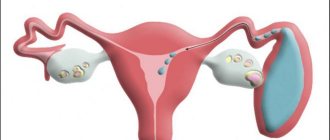Main symptoms:
- Lower abdominal pain
- Pain during sexual intercourse
- Bloating
- Loss of appetite
- Digestive disorder
- Nausea
- Frequent urination
In terms of prevalence, ovarian cancer ranks seventh among types of cancer relevant to women. Most often, the course of the disease is characterized by its own invisibility, and signs indicating it appear already when the cancer has largely spread. It is noteworthy that ovarian cancer, the symptoms of which are characterized by a similar feature, is detected at the initial stage in only a third of women.
- general description
- Types of disease
- Stages of ovarian cancer
- Symptoms of ovarian cancer
- Causes
- Treatment
General description of the disease
Ovarian cancer is a group of different types of tumors that arise in different tissues in the ovaries. The most common type of cancer is one in which cancer cells spread along the surface of the ovaries. Benign tumors and cysts are most often found in this area. Ovarian cancer predominantly occurs during perimenopause or postmenopause. In addition, an increased risk of possible cancer development occurs in women diagnosed with infertility, in women who gave birth to their first child late, and in women who experienced menopause late.
An increase in the risk of possible development of cancer in this area is relevant if there is a family or personal history of breast, endometrial or colon cancer. Considering the fact that it is almost impossible to determine the initial stage, which we have already noted, the diagnosis occurs quite late. Early diagnosis does not involve a specific screening test. Even regular pelvic examinations, blood tests and ultrasound examinations, which are inherently aimed at detecting ovarian cancer in the early stages, cannot give an accurate determination of the presence of this disease.
Treatment
Based on the stage of the disease, it is possible to determine the required type of treatment for an ovarian tumor - the extent of the surgical stage and individual selection of a course of polychemotherapy. The standard is to remove the uterus with appendages and greater omentum. The operation must be performed to a radical extent for the detected pathology.
At the Oncology Research Institute named after N.N. Petrov has created a unique operating room with KarlStorz equipment (Germany), where the largest surgeons in the North-West perform surgical treatment of all malignant pathologies of the reproductive system, including laparoscopic access.
The Department of Gynecological Oncology also deals with such a serious problem as surgical treatment during pregnancy. Cases of the need to remove an ovarian cyst during pregnancy are not uncommon, and limitations in radiological diagnostics often leave questions when making a clinical diagnosis. It is most rational to operate on pregnant women with ovarian tumors in a planned manner, having determined the nature of the tumor through urgent intraoperative cytological and histological studies.
Ovarian cancer: types of disease
As you know, a woman has two ovaries, which are located on both sides of the pelvis. They produce female hormones (progesterone and estrogen), as well as eggs. The ovaries themselves are covered with epithelial cells, and the vast majority of tumors develop precisely due to these cells. In accordance with the specifics, types of cancer are distinguished: primary and secondary cancer, as well as metastatic cancer.
- Primary cancer (endometrioid cancer). It predominantly appears as a bilateral lesion. In this case, tumors are characterized by their own tuberosity and density; they reach significant sizes only in rare cases. The morphological structure determines the diagnosis as glandular cancer, with foci of squamous epithelium. Most often occurs under the age of 30 years.
- Ovarian cancer is secondary. It mainly develops against the background of cystomas, which are benign cystic tumors. Cystic tumors are characterized by various sizes and can reach gigantic levels in them. Their contents may be a clear watery liquid, mucus, or a lubricant-like substance. They mainly become malignant in serous cystomas and in papillary-type growths, similar to the appearance of cauliflower, when they partially fill the cavities of the cysts. As a rule, serous cancer occurs between the ages of 40 and 60, and mucinous cancer occurs after the age of 60 years.
- Ovarian cancer is metastatic. This type of cancer can form from any type of organ that is affected by cancer, but the most common cases are stomach cancer. Tumor cells from there are carried through the bloodstream or along the lymphatic tract (retrograde). Metastatic cancer is characterized by rapid self-growth, as well as a more malignant course. Often the lesion spreads to both ovaries. The tumor moves to the pelvic peritoneum quite early, and numerous tumor tuberous nodes are formed.
Symptoms of ovarian cancer in women. Treatment, prognosis
Ovarian cancer is a malignant disease that usually affects women over the age of 50.
The pathology is very common and ranks second after cervical cancer. Symptoms of ovarian cancer in women in the early stages are not specific, so they can easily be confused with the clinical manifestations of another disease. The disease is characterized by latent development, which leads to late diagnosis and a high mortality rate. “The silent killer” is what doctors call this pathology. The prognosis of survival after surgery for ovarian cancer depends on many factors: the patient’s age, stage of the disease, the presence of concomitant diseases, emotional and psychological mood, etc. Depending on the structure, the following types of cancer are distinguished:
- endometrioid (primary);
- secondary;
- metastatic.
The causes of the disease are still unclear. However, there are certain factors that contribute to the development of the disease in a woman. These include: hormonal disorders, hereditary factors, the presence of certain gynecological diseases, irradiation of the body, unhealthy diet, harmful impurities and unfavorable environmental conditions.
Symptoms that determine classification
According to the specific stage, ovarian cancer has certain symptoms and characteristics. Briefly they look like this:
- Stage I – the tumor is limited to only one ovary;
- Stage II – tumor damage to one or both ovaries with simultaneous spread to the pelvic area;
- Stage III - the tumor spreads to one ovary or both, metastases occur along the peritoneum outside the pelvis, in addition, in combination or separately, the retroperitoneal lymph nodes also undergo metastases;
- Stage IV - the tumor spreads to one ovary or both, metastases have a distant nature.
Classification of ovarian cancer by stages (TNM and FIGO, 1997)
Ovarian Cancer: Risk Factors
Hormonal factor. According to doctors, there is a connection between ovarian cancer and the number of births and hormonal levels. Pregnancy, breastfeeding and taking oral contraceptives reduce the risk of developing pathology. And early onset of menstruation, infertility and late menopause, on the contrary, are factors contributing to the occurrence of the disease.
Heredity. If the disease was diagnosed in a mother, sister or grandmother, the woman needs to be especially careful and undergo regular medical examinations with a gynecologist. Testing for tumor markers for ovarian cancer will help identify the disease at an early stage of development.
Unhealthy eating. According to experts, pathology is diagnosed more often in women who consume excess amounts of animal fats.
Harmful impurities. Using talcum powder for hygiene purposes can also trigger the development of ovarian cancer.
Classification of pathology:
- the first stage – organic lesions under one ovary;
- second stage – damage to two ovaries;
- the third stage – the occurrence of metastases along the peritoneum;
- stage four – extensive distant metastases.
Ovarian cancer: symptoms
Ovarian cancer is characterized by nonspecific symptoms, usually masquerading as one or another common disease. In particular, these may include diseases of the digestive system or diseases that occur in the bladder area. Often a false diagnosis is made due to similar symptoms, while the diagnosis of cancer, again, occurs at a later stage.
The main feature of cancer is the constant presence of specific symptoms or their gradual worsening. For example, diseases of the digestive system, for which cancer can initially be mistaken, have a certain periodicity of their manifestations, while with cancer, the symptoms, as we noted, can be constantly present and worsen. The most common symptoms among women with the diagnosis we are considering are the following:
- Feeling of overeating, bloating or bloating;
- Urge to urinate immediately;
- Pain in the pelvic area, feeling of discomfort;
- Flatulence;
- Nausea;
- Constant indigestion;
- Increased frequency of urination;
- Increase in waist size;
- Decreased appetite;
- Rapid weight change (up or down);
- Painful sensations during sexual intercourse;
- Pain in the lumbar region, lower abdomen.
Most women with this diagnosis also experience nonspecific symptoms, which most often include dyspepsia, premature satiation with food, bloating, lumbar pain, and pain caused by the accumulation of gases. Later stages of cancer are characterized by symptoms such as pelvic pain and anemia, abdominal enlargement due to the tumor, and cachexia.
The main symptom indicating cancer is determined during an examination or special study. It consists of the “fluffy” syndrome. A characteristic symptom of this disease is also the syndrome of pathological discharge, in which blood appears in the sputum and feces. This symptom is relevant both for large tumors and for small tumors.
Causes of ovarian cancer
To date, there is no clear cause of ovarian tumors. The risk group includes women who are not sexually active, who have not become pregnant, or who have become pregnant but have not given birth.
Predisposing factors
- hormonal disorders, including late onset of menstruation or early menopause, abnormal increase in the number of ovulations, endometrial hyperplastic processes, long-term ovarian cysts, uterine fibroids
- genetic predisposition/heredity;
- the presence of other tumor processes in the body, especially breast cancer and endometrial cancer.
An ovarian tumor can begin from unchanged ovarian tissue, gradually turning into malignant. Another form of development of ovarian cancer occurs against the background of a pre-existing disease, which is initially benign in nature - ovarian cysts. Some types of ovarian cysts are completely harmless; they disappear on their own and do not require additional treatment. The most common are the so-called “functional cysts” (corpus luteum cyst and follicular cyst).
Often patients do not report any complaints. Despite this, one cannot take the diagnosis of “ovarian cyst” carelessly. You should seek advice from a specialist - a gynecological oncologist, because most women who are diagnosed with a cancerous tumor in the ovaries feel absolutely healthy until the tumor reaches a large size and signs of ovarian cancer appear.
Specific symptoms of ovarian cancer:
- constant aching pain in the abdomen and lumbar region;
- an increase in the volume of the abdomen due to the formation of fluid in the abdominal cavity.
- the appearance of disruptions in the menstrual cycle and vaginal discharge mixed with blood;
- frequent urination or “false” urge; constipation;
Methods for diagnosing ovarian cancer
As noted above, timely diagnosis of ovarian cancer is a rather difficult task.
If there are no clinical signs or symptoms are few and not expressed, then only regular visits to the doctor and monitoring the condition of the reproductive system organs can help in the early detection of cancer.
Only a quarter of all cases of malignant ovarian tumors are detected in the first stage, the rest are detected at the stage of cancer leaving the organ, in the presence of metastases or complications.
The sequence of examinations for suspected ovarian cancer includes:
- Inspection and two-handed examination through the vagina or rectum reveals a dense, tuberous formation, possibly affecting both ovaries, or the presence of growth into the wall of the rectum or periuterine tissue. It is worth noting, however, that very small tumors cannot be felt even by a very experienced doctor.
- Ultrasound of the pelvic organs, abdominal cavity, breast. To study the ovaries, it is advisable to use transvaginal sensors and supplement it with Doppler mapping in order to establish the nature of blood flow in the affected organ.
- CT, MRI - allow you to obtain images of the affected tissues in different planes, determine the degree of cancer ingrowth into surrounding organs, the presence of metastases in the lymph nodes, etc.
- Laparoscopy followed by morphological examination of the tumor.
- X-ray examination of the lungs and gastrointestinal tract to exclude both metastases and primary tumors, as in the case of Krukenberg cancer.
histological examination is an informative method for diagnosing tumor tissue.
The most reliable diagnostic method is considered to be histological examination of fragments of tumor tissue, and to make a correct diagnosis, a large number of examined areas of the removed tumor and the attentiveness of the doctor are required. It is better to refuse cytological diagnosis of abdominal effusion so as not to provoke the spread of cancer cells throughout the peritoneum, but in severe stages, when surgical treatment is no longer planned, such a procedure can only be performed to confirm the diagnosis.
Determination of tumor markers for ovarian cancer in the blood of patients is important in confirming a malignant tumor, although their increase also occurs in benign neoplasms. An increase in the concentration of the CA-125 protein is considered characteristic of epithelial ovarian tumors; in some cases, alpha-fetoprotein, LDH and other indicators increase.
In addition to the listed diagnostic stages, the patient will definitely undergo a general and biochemical blood test, determine the concentration of sex hormones, and, if necessary, undergo mammography and other studies.
Particular attention should be paid to women with an unfavorable family history, as well as those suffering from inflammatory processes of the pelvic organs, ovarian dysfunction, and infertility. At the very least, they should undergo an examination by a gynecologist and an ultrasound scan at least once a year.
Video: ovarian cancer on ultrasound
Surgical treatment and chemotherapy for ovarian cancer with metastases
The type of treatment depends on the patient’s age, her general condition and the stage of the tumor.
Surgery involves removing the uterus, fallopian tubes, ovaries, and greater omentum. As a rule, appendages are removed from both sides. In addition, during the operation, metastases are removed and lymph nodes are reviewed, followed by histology. If we are talking about a woman of childbearing age, then the doctor, taking into account the clinical picture and stage of the tumor, may recommend unilateral adnexectomy and omentectomy with mandatory chemotherapy. This is done in order to preserve the woman’s reproductive function.
Chemotherapy is given before and after surgery. In this case, cytostatics are used: cisplatin and melphalan. Chemotherapy for ovarian cancer with metastases as an independent treatment is justified in cases where surgery does not make sense.
On our website Dobrobut.com you can make an appointment with a specialist who will tell you whether relapse is possible after removal of the ovaries and will help you decide on diagnostic tests.
Symptoms of a uterine tumor
Unlike many malignant neoplasms, carcinoma of the reproductive organ and/or ovaries can be detected at an early stage and treated. With timely implementation of therapeutic measures, the prognosis for the patient is most favorable.
Symptoms of uterine cancer are varied, however, the most common of them is the appearance of bloody discharge from the genital tract, which outwardly resembles menstruation, but occurs without connection with the monthly cycle. Any woman, especially over 45 years old, should pay close attention to this deviation. At a late stage of the disease, pain in the lower abdomen appears.
If you discover suspicious symptoms, you should consult a doctor as soon as possible and undergo examination. It is not a fact that the patient will have any serious pathology; perhaps the specialist will find only a benign tumor or will not see any significant deviations from the norm at all. However, it’s still worth taking insurance.
First of all, the doctor will conduct an examination in a gynecological chair, as well as palpation of the organs of the reproductive system, then, most likely, he will direct the woman to take a scraping or smear from the cervix, which can be used to identify carcinoma. If the diagnosis is confirmed, the patient will be asked to clean out the inner layer of the reproductive organ using general anesthesia. At the same time, samples will be taken from the uterine mucosa for further examination and a final diagnosis.
A CT procedure is necessary when it is necessary to determine the exact localization of a neoplasm and detect the growth of lymph nodes located near it, if they were involved in the pathological process. If a woman is diagnosed with cancer of the reproductive organ at an early stage, then it will be possible to completely cope with it through surgery. If not only part of the uterus is affected, but also the ovaries, surgical intervention will also be performed on them. The use of hormones will be advisable only in the later stages of the disease.
Menstruation with ovarian cancer
Since the ovaries produce hormones responsible for female reproductive function, if they are affected by atypical cells, menstrual irregularities occur. Menstruation, in this case, has its own characteristics.
If the neoplasm is localized in one of the paired organs, then periodic delays in menstruation occur.
When both ovaries are affected, the second stage of the disease begins, which is characterized by the following symptoms:
- menstrual flow becomes scanty, as a deficiency of hormones occurs in the body due to a malfunction of the reproductive system;
- delays in menstruation become significant, as the processes of maturation of eggs and development of the endometrium are disrupted, and with some types of tumor amenorrhea is observed, the woman’s voice becomes rougher, and hair appears on her face;
- during menstruation, pain appears not only in the lower, but also in the side of the abdomen (where the affected paired organ is located);
- bleeding is observed after sexual intercourse or lifting weights, and sometimes for no reason, and the discharge, unlike normal, occurs under the influence of hormones produced by the tumor, occurs at any period of the cycle and for a very long time, is abundant.
Treatment methods for ovarian cancer
The main treatment methods include surgery and chemotherapy. The volume and nature of surgical intervention is selected taking into account the stage of the disease and age. With a good prognosis and early detection, young women with ovarian cancer may still be able to become pregnant.
If you need a second opinion to clarify your diagnosis or treatment plan, send us an application and documents for consultation, or schedule an in-person consultation by phone.
+7 499 490-24-13
Expert opinion
Symptoms of the disease
How does the disease manifest itself?
At the first stage of development of ovarian cancer, symptoms in women may not appear at all, show abnormalities similar to benign tumors, or be disguised as other diseases. For example, bladder dysfunction appears.
With further tumor growth, ovarian cancer symptoms and signs become more pronounced, the most characteristic being the appearance of bloody spots in the discharge.
The disease can manifest its development in the form of menstrual irregularities (but this symptom does not always appear immediately, more often with bilateral damage).
This type of cancer is characterized by the appearance of pain during sexual intercourse, discomfort in the lower abdomen and a feeling of fullness. The urge to urinate becomes frequent and sharp, and ascites (accumulation of excess fluid) gradually develops.
Symptoms of ovarian cancer in women may include pain in the lumbar region, an increase in waist diameter, indigestion, constipation, flatulence, and nausea. As the tumor grows, compression of the pelvic veins occurs, which is often accompanied by swelling of the legs and the formation of thrombosis.
Symptoms and signs of ovarian cancer are also of a general nature, which is characteristic of all types of cancer: decreased activity, lethargy, development of anemia, drowsiness, lack of appetite.












